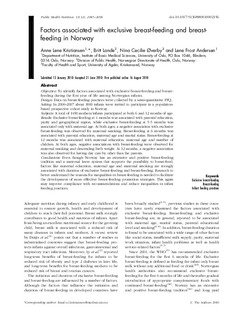| dc.contributor.author | Kristiansen, Anne Lene | |
| dc.contributor.author | Lande, Britt | |
| dc.contributor.author | Øverby, Nina Cecilie | |
| dc.contributor.author | Andersen, Lene Frost | |
| dc.date.accessioned | 2018-02-01T09:58:07Z | |
| dc.date.available | 2018-02-01T09:58:07Z | |
| dc.date.created | 2011-01-04T00:00:00Z | |
| dc.date.issued | 2010 | |
| dc.identifier.citation | Public Health Nutrition. 2010, 13 (12), 2087-2096. | |
| dc.identifier.issn | 1368-9800 | |
| dc.identifier.uri | http://hdl.handle.net/11250/2481160 | |
| dc.description.abstract | Objective To identify factors associated with exclusive breast-feeding and breast-feeding during the first year of life among Norwegian infants. Design Data on breast-feeding practices were collected by a semi-quantitative FFQ. Setting In 2006?2007 about 3000 infants were invited to participate in a population-based prospective cohort study in Norway. Subjects A total of 1490 mothers/infants participated at both 6 and 12 months of age. Results Exclusive breast-feeding at 4 months was associated with parental education, parity and geographical region, while exclusive breast-feeding at 5·5 months was associated only with maternal age. At both ages, a negative association with exclusive breast-feeding was observed for maternal smoking. Breast-feeding at 6 months was associated with parental education, maternal age and marital status. Breast-feeding at 12 months was associated with maternal education, maternal age and number of children. At both ages, negative associations with breast-feeding were observed for maternal smoking and descending birth weight. At 12 months, a negative association was also observed for having day care by other than the parents. Conclusions Even though Norway has an extensive and positive breast-feeding tradition and a maternal leave system that supports the possibility to breast-feed, factors like maternal education, maternal age and maternal smoking are strongly associated with duration of exclusive breast-feeding and breast-feeding. Research to better understand the reasons for inequalities in breast-feeding is needed to facilitate the development of more effective breast-feeding promotion strategies. This again may improve compliance with recommendations and reduce inequalities in infant feeding practices. | |
| dc.description.abstract | Factors associated with exclusive breastfeeding and breastfeeding in Norway | |
| dc.language.iso | eng | |
| dc.title | Factors associated with exclusive breast-feeding and breast-feeding in Norway | |
| dc.title.alternative | Factors associated with exclusive breastfeeding and breastfeeding in Norway | |
| dc.type | Peer reviewed | |
| dc.type | Journal article | |
| dc.description.version | published version | |
| dc.source.pagenumber | 2087-2096 | |
| dc.source.volume | 13 | |
| dc.source.journal | Public Health Nutrition | |
| dc.source.issue | 12 | |
| dc.identifier.doi | 10.1017/S1368980010002156 | |
| dc.identifier.cristin | 714615 | |
| cristin.unitcode | 201,18,2,0 | |
| cristin.unitname | Institutt for folkehelse, idrett og ernæring | |
| cristin.ispublished | true | |
| cristin.fulltext | postprint | |
| cristin.qualitycode | 1 | |
